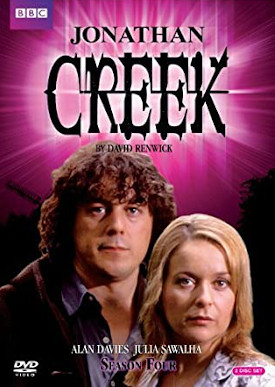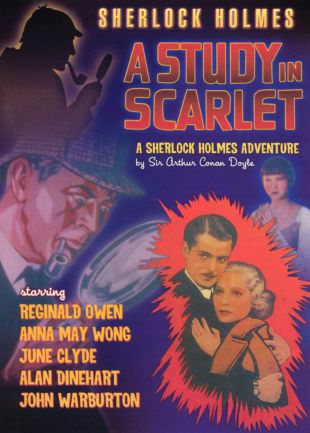Episode Details
Originally broadcast March 15, 2003
Season Four, Episode Three
Preceded by Angel Hair
Followed by The Seer of the Sands
Written by David Renwick
Directed by Christine Gernon
Familiar Faces
Maureen Lipman has had a celebrated and varied career, making it hard to point to just one or two standout roles. Audiences will perhaps be most familiar with her for her role as Evelyn Plummer in Coronation Street over the past few years while Doctor Who fans will remember her playing the Wire in The Idiot’s Lantern, an early David Tennant episode.
Nicholas Jones is best known to my kid for playing the Grand Wizard in The Worst Witch but he has made a lot of appearances in mystery-themed shows including Lewis, A Touch of Frost, Silent Witness, Rebus, Foyle’s War and two appearances in Midsomer Murders.

The Verdict
The core impossibility is very cleverly worked but other aspects of the episode feel quite heavily padded.
Episode Summary
Fashion designer Marco Bergman has enjoyed enormous success as a fashion designer, running his own celebrated fashion label which employs his children. Those children are returning to the house they share with him one evening when they are startled to see him stood in the window of his upper story bedroom, preparing to jump. Moments later he takes the leap and when they reach him they find him already dead.
Meanwhile a critic who has savaged Marco in a recent newspaper article is staying in a hotel room when she is threatened by an attacker who when briefly removing his mask can be seen to be Marco’s son Claude. When the manager knocks on the hotel room door the attacker hides behind a shower curtain but when the manager picks up on her signals and investigates they are shocked to find a completely different man than the one she expects to find there…
My Thoughts
When I first watched Jonathan Creek I was not as focused on the idea of the impossible crime as I am these days. To my less trained eye most of the show’s plots were utterly baffling and startlingly original, so it was hard for a teenaged and inexperienced Aidan to distinguish a great impossibility from a good one. As long as a story didn’t contain an obviously barmy or flawed plot (yes, I am talking about you – The Curious Case of Mr. Spearfish), my best metric for judging an episode was how much it entertained me.
Prior to revisiting it for this post, I remembered quite a lot about The Tailor’s Dummy from earlier viewings, including the solution to its impossibility. Those memories were of a fairly average story – certainly not an episode that stood out to me at the time. That may go some way toward explaining why I was so surprised to read a comment from TomCat, an expert in the locked room and impossible crime story whose taste and judgment I really trust, in response to my previous Creek post that praised this particular episode in strong terms. This made me all the more interested to revisit and reassess it.
We should begin with the core impossibility which is the business in the hotel room with the attacker who appears to have two completely different faces. While this is not the central problem of the episode, that would be the business about the curious circumstances surrounding the death of the fashion designer, it is this part of the story that provides the strongest sense of wonder.
The scenario is a striking one, in part because Renwick is so good at clearly defining the space and the circumstances around it. As in many of the best impossible scenarios, every aspect of the situation appears carefully accounted for. The manager of the hotel can serve as a witness while the physical conditions are very precisely established and can be easily checked. In short, we have a situation that feels genuinely inexplicable.
The solution to the impossibility is quite audacious for reasons that I will address in the Aidan Spoils Everything section below but while Renwick clearly dreams big, rather than being frustrated by its audacity, I can appreciate the clever construction of that solution. As with many of the best impossibilities, once you find the right questions to ask everything becomes quite clear and the problem can be broken apart by thinking it through logically.
The bigger mystery of the circumstances that caused a fashion mogul to jump to his death is similarly audacious in its conception. In some respects it may even be cleverer than the impossibility but as much as I appreciate the basic idea for how this might be achieved, I simply could not believe that it would work in practice. I will say however that I did like the clue of the bird cage which is a really good one and is perhaps wasted on the
Putting to one side the question of how it was done, the question of who did it is not much more satisfying. The villain’s identity can be inferred quite simply from the circumstances surrounding it, particularly given that there is not much going on when the event first takes place to misdirect the viewer.
On a more positive note, I do think that there are aspects of the story leading up to the big reveal that do work quite well. There is a moment in which a character is placed in peril that is created quite effectively that does show the villain in quite a brutal light and while the killer’s reaction following their unmasking felt a little too big to me, I had enjoyed their performance a lot up until that point.
It should be said that were I purely basing my enjoyment of this story on those mystery elements I would still be ranking this in the top half of my list. The bigger issues I have with the story lie in its secondary plots.
Let’s start with the return of terrible magician Kenny Starkiss played once again by Bill Bailey. The character had previously appeared in Satan’s Chimney and looking back on my review of that special I note that I never actually commented on the character – at least, not in the spoiler-free section of that post. Given that this is his second and last appearance (at least at the time of writing), I probably ought to pass some spoiler-free comment on him.
I come to the character as someone who enjoys Bill Bailey a lot outside of Jonathan Creek. While I watch fewer panel-type TV shows these days after living in the US for over a decade, at the time this was broadcast I always enjoyed seeing him crop up on a show. I actually think he is well suited to play this character of Kenny and I think that the character is used pretty thoughtfully within the grander scope of both episodes he appears in.
I am less enamored with his own subplot however, not for the initial scene in which we see his terrible act (which amuse you if you enjoyed the joke that he is a magician who doesn’t do magic) but the more serious scenes that follow it. I recognize that if you’re going to bring Bailey back you need something for him to do but I think that the story, like several others that attempt to represent the more realistic world of organized crime, doesn’t convince.
Another running theme throughout this episode is the way Jonathan and Carla keep getting thrust into awkward and intimate situations together. It’s not that the scenes are inherently bad – in fact I would suggest that they are better than many of the comparable scenes we had with Maddy in the first few seasons – but I think it leans into that dynamic too quickly and without much sense of resolution in this episode (it gets picked up again in the following one but that’s a story for another day).
My bigger issue though is with the awkward use of Brendan within the episode. Now, I have been relatively positive about the character and the way he is used to comment on the television industry in my previous Season Four posts. We get a little more of that here with the discussion of the Japanese reality show he is attempting to bring to British screens and the idea that television producers are more interested in creating dynamic situations than being responsible towards the people they involve in creating that programming. While I wouldn’t call those observations particularly challenging, they feel pretty relevant to some of the issues we have seen in recent years with participants in reality TV shows.
The material with Brendan pushing Carla into positions where she should get close to Jonathan, though it clearly is making her uncomfortable, is pretty painful to watch. More problematically, it also makes the character seem ludicrously disconnected with reality. I recognize that airy-headedness is an aspect of Brendan’s character but it makes him seem almost cartoonish (and while I don’t want to get ahead of myself too much, it will get worse).
Thinking back to how I felt about this episode before I revisited it, I find that my opinions have shifted. I do recognize the appeal and the cleverness of the impossibility which definitely appealed to my imagination and I appreciate how carefully it is constructed. On the other hand, I feel that my dislike of the Brendan material and Kenny’s subplot has probably increased and I am more conscious that it feels like padding. It’s still one of the better episodes in this fourth season but I think it doesn’t really compare to the best stories from the first two seasons.
Aidan Spoils Everything
ROT-13: Gur vzcbffvoyr fvghngvba urer vf irel pyrireyl pbaprvirq ohg erdhverf zber guna n yvggyr fhfcrafvba bs qvforyvrs. Ubj qbrf gung pbairefngvba pbzr hc jurer fbzrbar fbhaqf bhg n ubgry znantre nobhg znxvat n frevrf bs punatrf gb ubgry ebbzf gung, vs qvfpbirerq, jbhyq qrfgebl phfgbzre pbasvqrapr va ivfvgvat gung rfgnoyvfuzrag? Ubjrire fpnguvat gung erivrj jnf, vf vg ernyyl jbegu chggvat lbhe pnerre be ohfvarff ba gur yvar sbe? Vg srryf yvxr n erny fgergpu sbe zr orpnhfr juvyr gurl unir fbzr qravnovyvgl vs vg tbrf onqyl, gur qvfpbirel bs n gjb-jnl zveebe jbhyq or qvfnfgebhf.
Naq vg qrsvavgryl PBHYQ tb onqyl. Zveebevat fbzrbar pbaivapvatyl vf gevpxl naq cerfhznoyl jbhyq erdhver dhvgr n ovg bs cenpgvpr gb znxr vg jbex nf frrzyrffyl nf vg pyrneyl qbrf urer. Juvyr gurer vf n cbgragvny gung guvf pbhyq tb jebat, cnegvphyneyl vs fur pbasebagf ure nffnvynag, V pna npprcg gung gur evfxf ner eryngviryl ybj – cnegvphyneyl vs lbh znxr gur zveebevat cbegvba bs gur gevpx ynfg nf yvggyr gvzr nf cbffvoyr.
V unir ovttre vffhrf jvgu gur jnl gung gur snxr sver tbrf qbja. V xabj gung jura fbzrbar unf n ernyyl fgebat srne bs fbzrguvat gung gurve qrpvfvba znxvat zvtug or zber onfrq ba vafgvapg guna ernfba ohg vs lbhe gevpx obvyf qbja gb n fbhaqgenpx cynlvat ba n gvzrq PQ cynlre, fheryl vg jbhyq or boivbhf gung gur fbhaqf ner pbzvat sebz bar qverpgvba, rfcrpvnyyl jura lbh ner cercnevat gb whzc bhg bs gur jvaqbj. Vs n ibvpr gryyvat lbh gb whzc vf pbzvat sebz oruvaq lbh gura jbhyqa’g gung cebzcg fbzr qbhog jura pbzovarq jvgu gur ynpx bs fzbxr naq urng? Nf vg unccraf ur qbrf whzc ohg gura jung jbhyq bpphe vs ur unqa’g? Vg frrzf curabzranyyl evfxl…
Juvyr V unir fbzr vffhrf jvgu gur uhzna genssvpxvat cybg gung Xraal vf tvira urer (naq V nz onssyrq ol gur vqrn gung Wbanguna jvyy tvir uvz na bccbeghavgl gb svk vg orsber tbvat gb gur cbyvpr), V fgvyy nccerpvngr gur vqrn gung Xraal’f greevoyr aba-zntvp bapr ntnva tvirf hf gur fbyhgvba gb gur fgbel’f pber vzcbffvovyvgl. Vg’f n arng gevpx, cnegvphyneyl bapr lbh erpbtavmr vg, naq vg znxrf zr yvxr gung greevoyr zntvp frdhrapr nyy gur zber.




Leave a comment